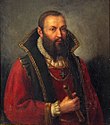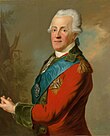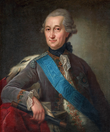Duchy of Courland and Semigallia
This article needs additional citations for verification. (March 2019) |
Duchy of Courland and Semigallia Ducatus Curlandiæ et Semigalliæ ( Latin) )Kurzemes un Zemgales hercogiste (Latvian) Księstwo Kurlandii i Semigalii (Polish) Kuršo ir Žiemgalos kunigaikštystė (Lithuanian) Herzogtum Kurland und Semgallen (German) Hertigdömet Kurland och Semgallen (Swedish | |||||||||||
|---|---|---|---|---|---|---|---|---|---|---|---|
| 1561–1795 | |||||||||||
 Duchy of Courland and Semigallia in 1714
| |||||||||||
| Status | Duke | | |||||||||
• 1561–1587 | Gotthard Kettler (first) | ||||||||||
• 1769–1795 | Peter von Biron (last) | ||||||||||
| Legislature | Colonial acquisitions | 1637–1690 | |||||||||
| 28 March 1795 | |||||||||||
| Area | |||||||||||
• Total | 27,290 km2 (10,540 sq mi) | ||||||||||
| Population | |||||||||||
• Estimate | ~200,000 (17th century) | ||||||||||
| Currency | Thaler | ||||||||||
| |||||||||||
| Today part of | Latvia | ||||||||||
The Duchy of Courland and Semigallia (
There was also a
at the end of World War I.History

| History of Latvia |
|---|
  |
| Chronology |
|
|
In 1561, during the
Several parts of the Courish area did not belong to the Duchy. The Order of Livonia had already loaned the Grobiņa district (on the coast of Baltic Sea) to the
Like the other members of the Order, Kettler was German and set about establishing the Duchy along the lines of similar German states. In 1570, he issued the Privilegium Gotthardinum, which allowed the landholders to
When Gotthard Kettler died in 1587, his sons,
However, relations between the duke and the landowners were quite hostile. In addition, the Polish–Lithuanian Commonwealth, which was the overlord of the Duchy of Courland, supported the landowners. Wilhelm expressed his disappointment with the landowners, but this ended with his removal from the duke's seat in 1616. Finally, Wilhelm left Courland and spent the rest of his life abroad. Thus, Friedrich became the only duke of Courland after 1616.
From 1600 to 1629, the Polish–Lithuanian Commonwealth and
Under the next duke,
Colonization
In 1651 the Duchy established its first
However, during this time, the Duchy of Courland remained an object of interest for both Sweden and the Polish–Lithuanian Commonwealth. In 1655 the Swedish army entered the territory of the Duchy, starting the
18th century
When Jacob died in 1682, his son,
Friedrich Casimir died in 1698. His successor,

After the death of Friedrich Wilhelm, the next candidate for the seat of duke was
Von Biron received remarkable financial support from Russia and invested it in construction – for example, the castle of
King
Dukes of Courland and Semigallia
| Portrait | Name | Lifespan | Reign | Consorts | Succession |
|---|---|---|---|---|---|

|
Gotthard Kettler | February 2, 1517 – May 17, 1587 | November 28, 1561 – May 17, 1587 | Anna of Mecklenburg March 11, 1566 Königsberg 3 children |
First |

|
Friedrich Kettler | November 25, 1569 – August 17, 1642 | May 17, 1587 – August 17, 1642 | Elisabeth Magdalena of Pomerania March 14, 1600 no issue |
Son of Gotthard Kettler |

|
Jacob Kettler | October 28, 1610 – January 1, 1682 | August 17, 1642 – January 1, 1682 | Louise Charlotte of Brandenburg October 9, 1645 9 children |
Nephew of Friedrich Kettler |

|
Friedrich Casimir Kettler
|
July 6, 1650 – January 22, 1698 | January 1, 1682 – January 22, 1698 | (1) Elisabeth Sophie of Brandenburg April 29, 1691 2 children |
Son of Jacob Kettler |

|
Friedrich Wilhelm Kettler
|
July 19, 1692 – January 21, 1711 | January 22, 1698 – January 21, 1711 | St. Petersburg no issue |
Son of Frederick Casimir Kettler |

|
Ferdinand Kettler | November 1, 1655 – May 4, 1737 | January 21, 1711 – May 4, 1737 | Danzig no issue |
Uncle of Frederick William Kettler |

|
Ernst Johann von Biron | November 23, 1690 – December 29, 1772 | June 1737 – 1740 | Benigna Gottlieb von Trotha gt Treyden 1723 3 children |
Elected |

|
Louis Ernest of Brunswick-Lüneburg | September 25, 1718 – May 12, 1788 | June 27, 1741 – December 6, 1741 | Never married | Elected |

|
Karl of Saxony
|
July 13, 1733 – June 16, 1796 | November 10, 1758 – 1763 | Franciszka Krasińska March 25, 1760 Warsaw 2 daughters |
Appointed by Augustus III, King of Poland |

|
Ernst Johann von Biron | November 23, 1690 – December 29, 1772 | 1763–1769 | Benigna Gottlieb von Trotha gt Treyden 1723 3 children |
Reappointed by Catherine the Great |

|
Peter von Biron | February 15, 1724 – January 13, 1800 | 1769 – March 28, 1795 | (1) November 6, 1779 6 children |
Son of Ernst Johann von Biron |
Gallery
-
Greater coat of arms of the Dukes of Courland of the Kettler family
-
Naval Flag of Courland and Semigallia
-
German map of Duchy of Courland and Semigallia (about 1600)
-
Jelgava Palace, the main residence of the dukes
-
Sigismund Augustus King of Poland and Grand Duke of Lithuania incorporates fiefdoms, Duchies of Courland and Semigalia into the Crown in 1569
See also
- Coat of arms of Courland
- Duchess of Courland
- Courland
- Couronian colonisation
- Couronian colonisation of the Americas
- Ernst Friedrich von Ockel
- Livonia
- Semigallia
References
- ^ Volumina Legum, t. II, Petersburg 1859, p. 106
- ^ Volumina Legum, t. VI, Petersburg 1860, p. 209.
- ^ "How the Duchy of Courland was briefly resurrected in 1918". eng.lsm.lv. Retrieved February 8, 2023.
- ^ "Duke Gotthard". archiv.org.lv.
- ^ Palkans, p. 50.
- ^ "The Fall of Curonian Colonization". History & Culture Academy of Latgale.
- ^ a b McGee, James E. (1873). Sketches of Irish soldiers in every land. New York: Lang, Little & Hillman. p. 106.
Bibliography
- Ceaser, Ray A., Duchy of Courland, University of Washington, June 2001.
- Plakans, Andrejs (1995) The Latvians: A Short History, Hoover Institution Press.
External links
- Courland
- Courland 1641–1795
- Flags of Courland
- Die Kurländische Ritterschaft
- Ritterschaften der Familie in Kurland
 |







